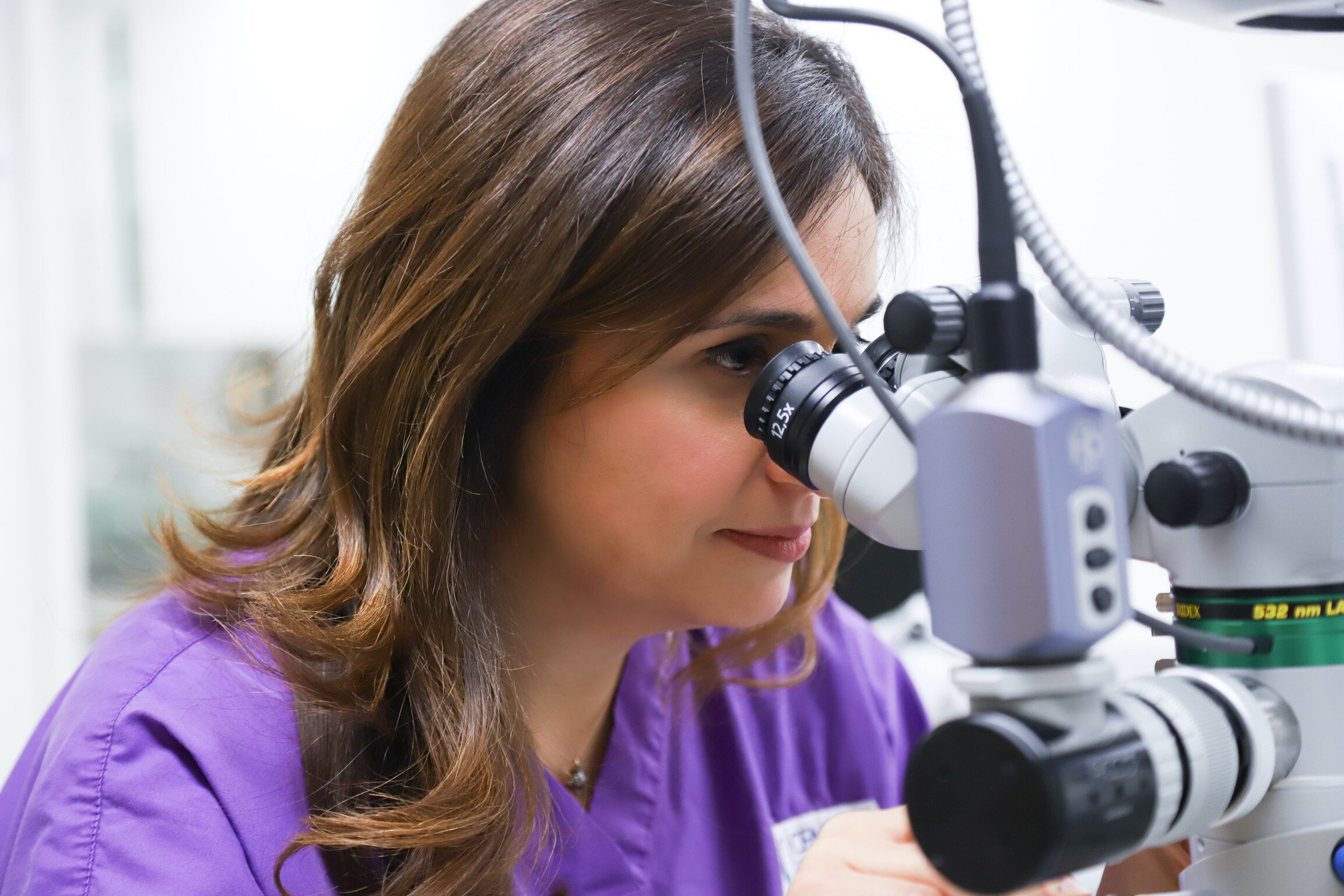CONDITIONS
Age Related Macular Degeneration
Age Related Macular Degeneration (ARMD) is a common condition affecting the Macular. The Macular is the central or middle part of the Retina (light sensitive layer at the back of the eye), this part of the eye is responsible for providing the best quality of vision.
It usually first affects people in their 50’s or 60’s. Patients may notice difficulties with their central vision, such as reading or recognising faces. They may also notice some distortion with their central vision, for example words appearing smaller than they are or lines appearing ‘wavy’ or ‘crooked’. ARMD doesn’t affect the peripheral (edges) of vision.
There are two types of ARMD : Dry and Wet.
The Dry type is the most common type, and involves a build up of waste material and a ‘wear and tear’ process in the central part of the eye. It usually progresses very slowly, there is currently no treatment for this, but supportive care can be provided.
The Wet type is less common, and involves the growth of new vessels underneath the retina. These vessels can leak and cause a sudden change in vision in days or weeks. Treatment can slow progression of visual loss and in some patients improve vision.
Dr. Izadi will discuss with you the ways of diagnosing this condition and differentiating between the types and if applicable any potential treatment options. Currently, treatment of Wet ARMD involves a course of anti-VEGF injections into the eye. These injections help to treat the leaking from the abnormal blood vessels underneath the Retina.
For further information refer to: https://www.macularsociety.org
Diabetic Macular Oedema
Diabetic Macular Oedema (DMO) is the most common cause of visual loss in diabetic patients. Over a long term high blood sugars can cause damage and leaking from blood vessels in the Retina (light sensitive layer at the back of the eye). If this leaking (Oedema) involves the Macular (the middle or central part of the retina) it is called Diabetic Macular Oedema (DMO) or Diabetic Maculopathy.
Patients may notice difficulties with their central vision, such as problems reading or recognising faces. They may also notice some distortion with their central vision, for example words appearing smaller than they are or lines appearing ‘wavy’ or ‘crooked’. DMO doesn’t affect the peripheral (edges) of vision.
Poor blood sugar control, smoking, high blood pressure and high cholesterol can worsen DMO. It is therefore of upmost importance that these factors are optimally controlled. Dr. Izadi will be happy to discuss this further and refer you back to your general physician or practitioner for this. She will discuss with you the ways of diagnosing this condition and if applicable any potential treatment options.
In early DMO treatment can involve Retinal Laser. However, in most cases treatment involves a course of anti-VEGF injections into the eye. These can help to reduce the leaking from the damaged blood vessels and help to prevent further visual loss and in some patients may even improve the vision. In some cases Steroid injections into the eye may also be considered.
For further information refer to: https://www.macularsociety.org
Retinal Vein Occlusion
This condition caused by a blockage (occlusion) in part of the circulation (the vein) in the Retina (light sensitive layer at the back of the eye). It can happen at any age, but usually effects people over the age of 60. Patients notice a sudden painless loss of vision or blurring of vision in one eye.
Risk factors include age, high blood pressure, high cholesterol, diabetes and glaucoma. Dr. Izadi will discuss with you the importance of referral to a general physician or practitioner so that these risk factors can be checked.
Patients with this condition may suffer with secondary problems arising form the blocked vein. Including leakage (Oedema) in the Macular (middle or central part of the retina) and even growth of new vessels, which can be harmful to the eye as the may bleed or cause high pressure in the eye.
Macular Oedema secondary to RVO: Dr. Izadi will discuss with you the ways of diagnosing this condition as well as any potential treatment options.
If the amount of macular oedema is minimal and the vision is unaffected, initially careful observation is all that is needed.
If required treatment usually involves a course of anti-VEGF injections into the eye. These can reduce the leaking from the damaged blood vessel and help to prevent further visual loss and in some patents may even improve the vision. In some cases Steroid injections into the eye may also be considered.
New vessel growth: This is treated with retinal Laser treatment to the peripheral retina.
For further information refer to: https://www.macularsociety.org
CATARACT SURGERY
Cataract is a natural ageing process of the lens in the eye. The lens at the front of the eye, much like an old fashioned camera lens, helps to focus light on to the Retina (light sensitive layer at the back of the eye). As we get older the lens can become cloudy and thickened and this is called a Cataract.
If the Cataract is not troubling the patient in anyway, then no action is needed. However it can cause difficulties for patients with painless symptoms including blurring of vision, trouble with reading and distance vision or glare when driving especially at night.
If you are troubled with cataract then they only way to treat this condition is with Cataract Surgery. Dr Izadi has a particular interest in performing such surgery in patients with Medical Retina conditions such as Diabetes, Age Related Macular Degeneration or Retinal Vein Occlusions.
Diabetic Retinopathy
Diabetic retinopathy is a complication of diabetes. In the UK everyone over the age of 12 with diabetes will be offered screening for Diabetic Retinopathy with the NHS. It is very important that eligible patients attend these appointments so that potential sight threatening changes can be picked up and treated early.
Persistently high sugar levels can cause damage to the blood vessels in the Retina (light sensitive layer at the back of the eye). This damage can lead to changes such as bleeding or leakage. If this leaking (Oedema) involves the macular (the middle or central part of the retina) it is called Diabetic Macular Oedema (DMO).
Poor blood sugar control, smoking, high blood pressure and high cholesterol can worsen Diabetic Retinopathy. It is therefore of upmost importance that these factors are optimally controlled.
Dr. Izadi will be happy to discuss this further and refer you back to your general physician or practitioner for this.
For further information refer to: https://www.nhs.uk/conditions/diabetic-eye-screening
Uveitis: Inflammatory Eye Conditions
Uveitis is an inflammation of the middle layer of tissue in the eye wall. It can affect the front, middle and back of the eye or the entire eye itself. Inflammation may be present in one or both eyes and may occur at any age.
Uveitis maybe caused by trauma, infection, underlying inflammatory or autoimmune conditions. However most commonly the cause can not be identified.
Patients may complain of painful, red eyes, light sensitivity, reduced or blurred vision or floaters. If left untreated it may lead to secondary complications such as Cataract and Glaucoma and loss of vision.
Dr. Izadi will discuss with you the ways of diagnosing this condition and if relevant will advise you of potential treatment options.



